Quick Summary:
Confused when to choose IT Staff Augmentation over Managed IT Services and when Managed Services is a better choice than IT Staff Augmentation? Here we will break down every aspect you need to know to make an informed decision for your business in this IT Staff Augmentation vs Managed IT Services comparison.
There is no one-fits-all solution when deciding between IT Staff Augmentation vs Managed IT Services. So, it’s not about choosing one over the other but about understanding what both these terms mean, when to use which, and the key considerations to keep in mind before implementing any of these models in your workplace.
Any development company must have a proper IT strategy in place. Without an efficient IT plan, you won’t be able to build a solid IT infrastructure and end up hiring over or under your requirements. With the advent of Industrial Revolution 4.0 and the onset of the global pandemic, digital transformation quickly became the new normal. The burden of meeting all expectations is falling on the enterprises. Hence it is important to understand the two widely popular models we have before implementing them – Staff Augmentation and Managed IT Services.
A brief about IT Staff Augmentation
Let’s start with IT staff augmentation. IT Staff Augmentation is meant to be a temporary solution that is generally used to overcome short-term limitations in terms of IT expertise. It is the process of hiring an employee for your internal team. The only difference is that you hire talent or a team for certain requirements over a certain period while holding the responsibility and control. Though talents hired through IT Staff Augmentation aren’t permanent, they are still fully integrated with your existing team.
IT Staff Augmentation Use Scenarios – When is IT Staff Augmentation right for you?
If you are confused about when to opt for IT Staff Augmentation services, you can refer to the following guide or use scenarios to see if it’s a fitting solution for your needs:
IT Staff Augmentation is for when:

1. There is Talent Supply Shortage
You have a team of engineers working on your project at your local office but need to extend your app development team to build another aspect of the product. For this, you need 4-8 IT experts, but there is a clear shortage of talent in your local market. Hence, traditional recruitment is not viable as it will take too long and is costly.
2. There is Talent Specialization Shortage
You are from a non-IT sector business but need to develop a technical product like an app or software. You start working with a team of developers but realize you need other professionals for a particular aspect of your app. You try hiring them from your local market, only to find out they are rare in your proximity. Hence you look to extend your search to farther locations.
3. Control is important to you
Compared to many other outsourcing models, IT Staff Augmentation is an out-staffing model where you are only hiring external talents as per the need and urgency of your project. You have an existing team of programmers and engineers and don’t want to hand over the control and responsibility of your project to a third-party service provider. IT staff augmentation helps you power your team without letting go of the management control.
Why do companies prefer IT Staff Augmentation over Traditional Hiring?
The traditional recruitment process can be highly exhausting and costly. Hiring a talent by the normal process would require conducting interviews, registering employees, going through an exhaustive onboarding process, paying fixed salaries, and going through the legalities of even terminating an employee properly. Here is how IT staff Augmentation provides better value
- Easy access to skilled professionals
- More cost-effective than recruiting
- Access to specialized talents as per project requirements
- Working hours flexibility
- An objective and fresh perspective from an outsider’s point of view
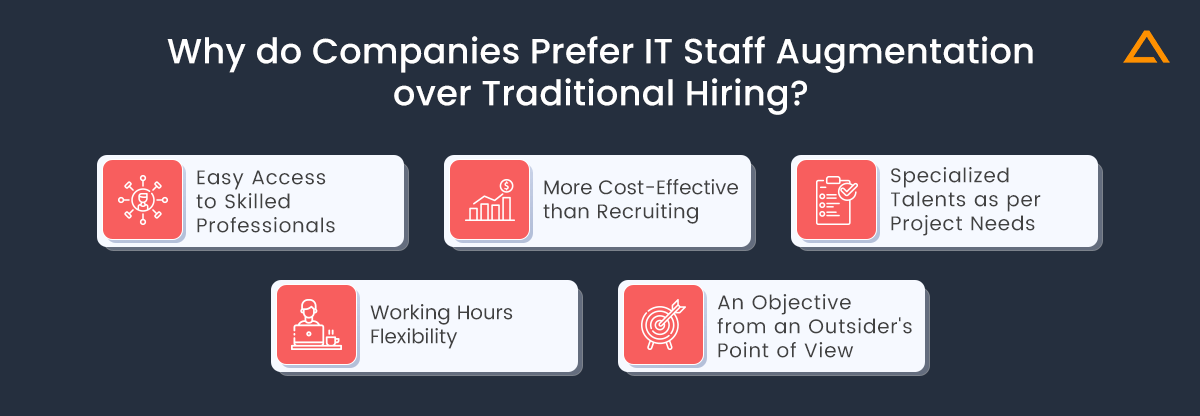
Hence IT Staff Augmentation works as a great workaround to the traditional recruitment process when you need highly skilled talents as urgently as possible while saving up on costs.
Stats that prove the importance of IT Staff Augmentation Services
- A recent study by ManpowerGroup, a global staffing firm, found that 77% of employers worldwide are struggling to fill job vacancies, marking the highest talent shortage in 17 years.
- In a comprehensive yearly survey, it shows that 41 countries involving 39,000 employees has seen increase of 2% compared to previous year in filling the positions. This figure is more than twice the 2010 rate of 31%, indicating a significant and growing challenge for businesses worldwide in finding suitable talent for their job vacancies.
- According to reports by the Bureau of Labor Statistics (BLS) and CompTIA, the US tech sector observed a rise in unemployment from 1.5% in January to 2.2% in February. Despite this increase, the unemployment rate for tech occupations remains notably lower than the overall rate of 3.5%.
Business Benefits of IT Staff Augmentation
There are countless IT projects, and any company can only have so many in-house talents to keep up with the client’s demands in terms of volume or new technologies. Hence, it becomes imperative for them to be more flexible in their hiring approach and take advantage of IT Staff Augmentation services to hire professionals as and when required to meet their project requirements. Here are some of the major benefits of hiring IT Staff Augmentation services for your business:

1. Improved Scalability
The demand for new technologies, better skills, and a higher number of developers will only increase over time in this technology-driven era. No matter how big your remote technical talent pool is, if you don’t opt for out-staffing or outsourcing approaches, you will not survive the intense competition in the market. By leveraging IT Staff Augmentation services, you can take up projects of any scale and never need to deny a client’s demand. You can also expand your range of services by introducing new specializations as per the ongoing demand.
2. Improved Cost Effectiveness
One of the greatest IT Staff Augmentation benefits is cost-cutting for companies at various levels. You only need to pay IT staff augmentation professionals for the duration of their services. It saves major costs on setting up a professional recruitment process, eliminates the need for the employer to pay for employee benefits, taxes and deal with other such legality. In addition, you don’t need to pay for training these talents as you hire them for their expertise in that particular field.
3. Highly Skilled Short-Term Combination
IT Staff Augmentation gives you the best of both worlds, highly skilled professionals in specific niches, without any commitment or binding to keep them for longer durations than required. It enables businesses to expand their potential, helping them better deliver on their deadlines or push for more aggressive deadlines to get a competitive edge.
4. Quicker Market Response
Hiring highly skilled developers through IT Staff Augmentation services eliminates the need to undergo a lengthy and exhaustive recruitment process with onboarding full-time talents. Since you can expand your capacity faster, you can react to any demands or convert a potential client instantly to facilitate the minimum requirements for taking on such market opportunities.
As every coin has two sides although staff augmentation provides number of advantages it also encounters some challenges and some of them are mentioned below:
Business Challenges of IT Staff Augmentation
While IT Staff augmentation provides various benefits it also comes with its own set of challenges. Some of the crucial business challenges may face with IT staff augmentation are as follows:

Cost Management
Augmenting staff can be more expensive than hiring full-time employees, especially when factoring in recruiting fees, higher hourly rates for contractors, and lack of benefits. There are extra costs associated with managing and training contract workers as well.
Work Control
Companies have less control over contract workers compared to full-time employees. It may be harder to enforce policies, practices, and culture with augmented staff.
Knowledge Transfer
There is a risk of knowledge staying with contract workers rather than transferring back to internal teams. This can be mitigated with proper documentation and knowledge sharing practices.
Quality Inconsistencies
The quality of augmented workers can vary more than full-time hires. Thorough vetting, reviews, and clear expectations help mitigate this.
Lack of Loyalty
Contract staff may lack the loyalty and commitment of full-time employees. They may leave for better contracts. This can lead to higher turnover and retraining costs.
Security Risks
Contractors may not be as thoroughly vetted from a security standpoint. Companies need to ensure proper access controls andsecurity practices are enforced for temporary workers.
Integration Challenges
It may be harder for contract workers to integrate into the corporate culture. This can negatively impact collaboration and team cohesion.
To mitigate these risks, companies should have clear augmentation strategies, onboarding/training, strong supplier relationships, and the ability to convert high performers to full-time roles. The benefits of skills flexibility and ramping up/down capacity may outweigh the challenges.
Things to keep in mind before hiring the right IT Staff Augmentation Service Providers
There are a couple of things to keep in mind before hiring the right IT Staff Augmentation service provider for your urgent hiring requirements. Keep these points in mind before making your decision:
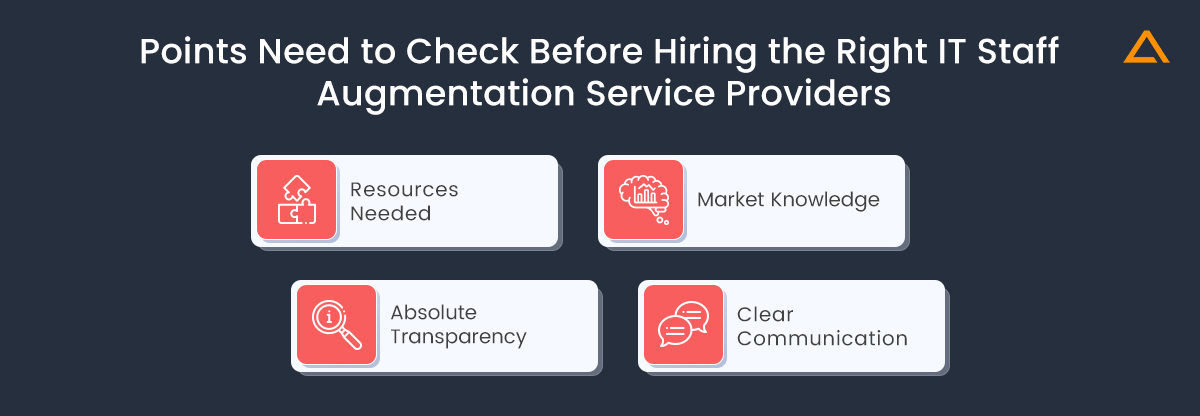
1. Resources Needed
There are many types of IT staff augmentation companies across the globe. To declutter from the noise, you should first define the resources you need for your business and then look for IT staff augmentation services that cater to those particular services. Selecting specialized personnel with the right skill fit is beneficial for the company.
2. Market Knowledge
Your selected IT staff augmentation partner should be updated and ahead of the curve about the latest tech-related changes and updates when searching for a fitting candidate for your requirement. Shift your IT staff augmentation company if you feel slower to react to changing markets.
3. Absolute Transparency with Clear Communication
A partnership can’t work with secrets and inefficient communication. Your staffing agency should be able to provide you with clearly defined roles, responsibilities, and deliverables in a well-documented file. They should also provide a clear and easy to understand cost-breakdown of all their services, including any hidden charges (if any).
Is your business need a revolution in Digital Transformation?
Aglowid delivers scalable digital transformation services with science-led innovation to keep up with the speed of disruption
Now that you understand the importance and potential benefits of hiring an MSP, you should also focus on setting selection criteria for hiring the right Managed Services Provider for your business. Here are some of the essential checkpoints you should assess any MSP from:
A brief about Managed Services
Another route you can take is to opt for Managed IT Services. Here you transfer the control over your business management processes to a specialized IT firm. Unlike Staff Augmentation, which follows out staffing approach, Managed Services takes the outsourcing approach. Here the responsibility of getting the work done is also transferred to the Managed Services Provider.
Such services are best suited for companies that require a specific technical output but don’t necessarily have the right talents or an IT department to play an active role in the process. The client sets the deliverables and benchmarks for the project’s success. The MSP (Managed Service Provider) is responsible for meeting these deadlines and setting goals under the Service Level Agreement (SLA). Generally, Managed Services are charged on an annual subscription basis.
IT Service Management Use Scenarios – When to leverage Managed IT Services?
When should you go for Managed IT Services? Is MSP the right fit for your business requirements? If you have such questions bothering you, take a quick look at the different user scenarios where it makes sense to opt for Managed Services:

1. When you want to focus on Core Objectives
Organizations with no IT professionals who want to free up their team to focus on other important strategic decisions can opt for Managed IT services for outsourcing their IT requirements at cost-effective rates.
2. When you have different challenges as per your business scale
Start-ups that don’t have the financial resources to set up their own IT staff, growing SMEs that may have one-time or occasional need for IT services or professional businesses like insurance agencies, accounting firms, and others that require Staff to focus on their profession than worry about IT infrastructure.
3. When you need a reliable IT partner
Partnering with a top Managed Service Provider will offer you 24/7 availability, work time zone flexibility, and weekend support for any urgent or occasional IT requirement that might arise. With a team that always has your back, you won’t miss out on good opportunities nor be completely handicapped in times of uncertainty.
Stats that prove the importance of IT Managed Services
- As per a report published on Statista, in 2021 the global managed services market was valued at 161.37 billion US dollars and is expected to exceed 300 billion U.S dollars by 2027.
- According to the Deloitte Study, 57% of executive indicate a budget increase for managed services & 76% of executive indicated that IT functions are outsourced.
- According to a study conducted by Grand View Research, the Global IT services outsourcing market size was valued at $520.74 billion in 2019. They also estimate this will grow at a 7.7% CAGR in the duration 2020-2027.
Business Benefits of Managed Services
There are many benefits of opting for Managed Services for your IT requirements. If you’re from a technical background and have a team of IT experts, you can still leverage Managed Services for outsourcing the lesser important tasks to free up your time to focus on the core services. If you are from a non-technical background, you want to outsource the entire IT department through Managed Services and focus on core business objectives. Here are some of the benefits of hiring Managed Service Providers:

1. Credible Expertise and Proven Experience
One of the most important benefits of leveraging IT Managed Services is that you onboard a team that checks all the checkboxes of a must-have IT team. They have the right qualifications, training, industry-specific experience, and certifications as per your needs. By hiring such a team, your business would also enjoy staying ahead of the curve by leveraging the latest technologies on the market.
2. Data and Industry Compliance Support
Different industries have different compliances acts that any business belonging to those categories needs to follow. In addition, they have guidelines that can heavily influence how the solution is developed and designed. An efficient managed IT services company will be well-versed with all different compliances and take responsibility for ensuring your solution adheres to any required compliances by law.
List of some compliances–
- HIPAA – Health Insurance Portability and Accountability Act
- GDPR – General Data Protection Regulation

3. Cost-Effectiveness and Return on Investment
Hiring a Managed Service Provider is financially beneficial for the companies. It helps regulate outgoing expenses resulting in a better increase in investment. If you sit to plan your IT budget, you would realize there are many factors to consider the cost of like, IT labor, software and network infrastructure, and hardware expenses. Managed IT services handle all these operational costs while providing more flexibility and scalability that even an internal IT team can’t provide. By tracking IT expenses with ease, businesses can strategize better.
As every story has two sides, managed service is no different, while Managed service has many pros it also comes with various cons, some of them are as below.
Business Challenges of Managed Services
Embracing managed services comes with a set of hurdles for businesses to overcome. Learn how to navigate these challenges effectively to harness the full potential of managed services:
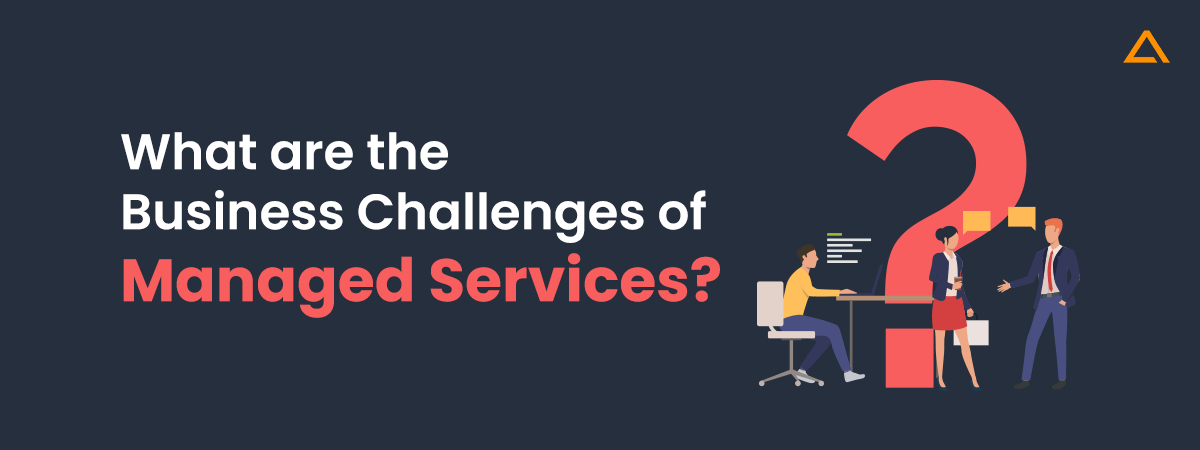
Cost Management
Efficiently managing costs within managed services requires thorough financial assessments to align ongoing fees with the allocated budget. Strategic evaluation of long-term cost-effectiveness and potential return on investment plays a vital role in making well-informed decisions for the company’s financial well-being.
Security & Compliance
When outsourcing IT, prioritize security and compliance necessitates meticulous scrutiny of managed services providers. Opt for vendors with extensive security protocols, certifications, and a proven track record of regulatory adherence to safeguard sensitive data and shield the organization from potential legal consequences.
Service Quality & Reliability
Given the reliance on external providers for business continuity, emphasizing exceptional service quality and unwavering reliability is paramount. Establishing clear service level agreements encompassing performance metrics, response times, and issues resolution protocols ensures consistent and trustworthy services.
Integration With Existing System
Seamlessly integrating managed services calls for comprehensive planning, diligent execution, and transparent communication. Thoroughly address compatibility concerns, data migration complexities, and potential operational impacts to achieve a seamless transition, minimizing disruptions, and maximizing the benefits of this new arrangement.
Now that we have compared both pros and cons of the managed services let’s take a look at the things that you should remember while selecting the right managed services provider.
Things to keep in mind before hiring the right Managed Services Provider for your business
Now that you understand the importance and potential benefits of hiring an MSP, you should also focus on setting selection criteria for hiring the right Managed IT Services Provider for your business. Here are some of the essential checkpoints you should assess any MSP from:
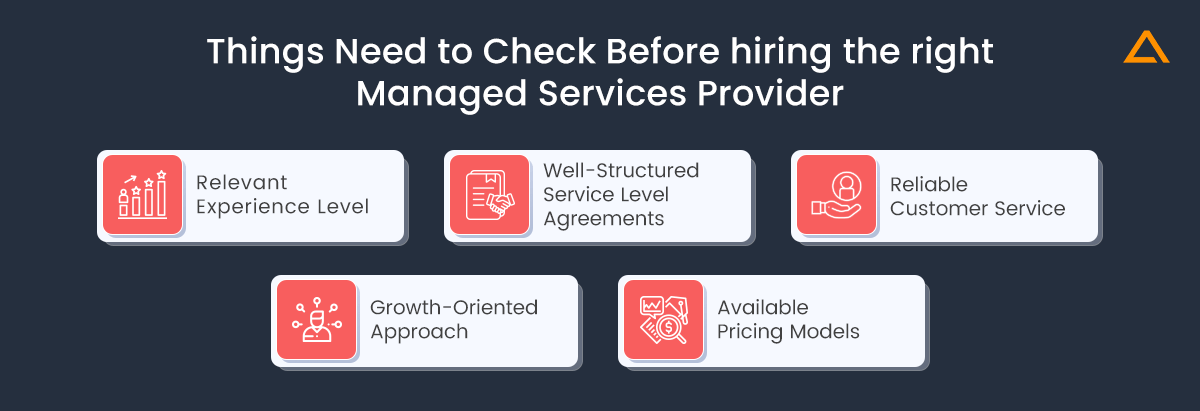
1. Relevant Experience Level in your Niche/Industry
While hiring MSPs, you are looking for trained professionals who understand your niche in and out. Suppose your potential MSP has a proven track record of handling similar projects for other businesses. In that case, it’s a positive indicator that they are familiar with the industry and accustomed to the industry’s norms.
2. Well-structured Service Level Agreements
Ambiguity is the biggest enemy of productivity. The same is the condition when partnering with a Managed IT Services Provider with poorly formatted and written SLA. An efficient MSP will provide flexibility to ensure proper compliance and proper response time in adjustment to company size and scope. A clearly defined Service Level Agreement is mutually beneficial for both the provider and the service user.
3. Reliable customer service
You need to ensure that whatever MSP you sign up with provides exceptional customer service. The customer service department is the group of people you’ll communicate with if something goes wrong. Their communication needs to be honest and easy to understand. Always go for a Managed Service provider that takes a proactive approach rather than reactive to help your business reach newer heights.
4. Growth-oriented approach
Your managed service provider needs to at all times be focused on your future. Therefore, they should always look for innovative approaches and have a proactive nature in adopting new technologies to identify new opportunities while being prepared for any challenges that may come up in the journey.
Available Pricing Models
An MSP can be as efficient as possible and tick all the right boxes; however, if their pricing models are limited and rigid, chances are they won’t be the right fit for your business requirements. Always hire a managed IT service provider that provides different pricing models to cater to your requirements.
IT Managed Services Vs Staff Augmentation Comparison
| Staff Augmentation vs IT Managed Services Comparison Table | ||
| Differentiator | Staff Augmentation | IT Managed Services |
| Service Approach | Input: Outsourcing tasks and functions | Output: Outsourcing management and solutions |
| Responsibility & Ownership | Retained by the client | Transferred to the Managed Service Provider |
| Risk | Retained by client | Transferred to the MSP |
| Service Type | Out-staffing | Outsourcing |
| Billing Frequency and Type | Based on time spent, generally bi-weekly | Bills on retaining, often charged annually |
| Best suited for | Short-term projects | Long-term projects |
| Engagement Model | Full-time | Full-time/Part-time |
| Commitments | None | Service Levels commitment |
As we previously stated at the beginning of the blog, there is no one-fits-all solution for meeting your development requirements to match the demand of various clients and maximize every opportunity. Deciding which model to choose for your specific requirements will depend on the mission statement, requirement, and focus.
Most businesses adopt a hybrid model where they use both these models for different purposes at different times or both models simultaneously to cater to different requirements. You should aim to utilize the benefits of both the available approaches instead of sticking to a single model. One good differentiator to keep in mind is to be clear about which is used for what is; IT-managed services can be compared to a telescope (future thinking, looking at the bigger picture). IT staff augmentation can be compared to a microscope (finding and fixing issues within the team, strengthening team capabilities).
Comparison of IT Solutions: When to Opt for IT Staff Augmentation or Managed Services
In the ever-evolving landscape of IT support, making the right choice between IT staff augmentation and managed services is critical for businesses. Following are the mentioned scenarios where you can use IT Staff Augmentation or Managed Services
IT Staff Augmentation
- Complement existing workforce for specific projects or tasks.
- Handle seasonal or peak workload efficiently.
- Bridge skill gaps in the existing IT team.
- Cost-effective solution for short-term or occasional projects.
- Bring in experts for new technology implementation.
- Flexible team size to match project requirements.
- Quick and efficient recruitment of specialized talent.
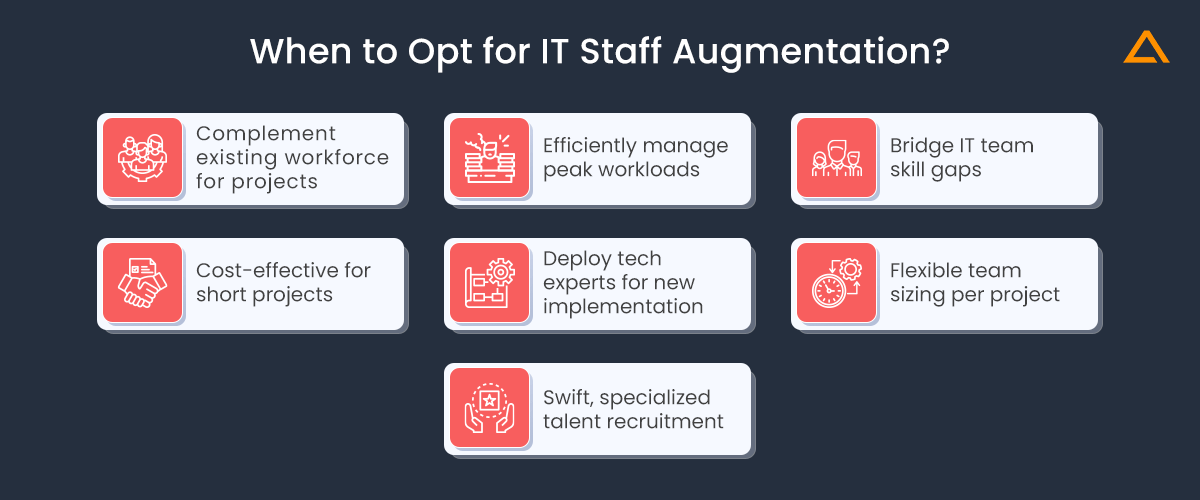
Managed System
- Proactive IT support with monitoring and issue resolution.
- 24/7 technical support and quick response times.
- Predictable monthly costs for budgeting.
- Allows businesses to focus on core operations.
- Advanced security measures and data protection.
- Easily scalable to accommodate business growth.
- Access to a team of skilled IT professionals.
- Ensures compliance with regulations and standards.

Wrapping Up!
In conclusion, businesses must carefully consider their specific needs and long-term IT goals when choosing between IT staff augmentation and managed solutions. While staff augmentation offers flexibility and expertise for short-term projects, managed solutions provide comprehensive, outsourced IT support, scalability, and reduced operational burden. A well-informed decision will optimize IT operations, enhance productivity, and ensure success in today’s dynamic digital landscape.
have a unique app Idea?
Hire Certified Developers To Build Robust Feature, Rich App And Websites.
Also Check:





 Say
Say